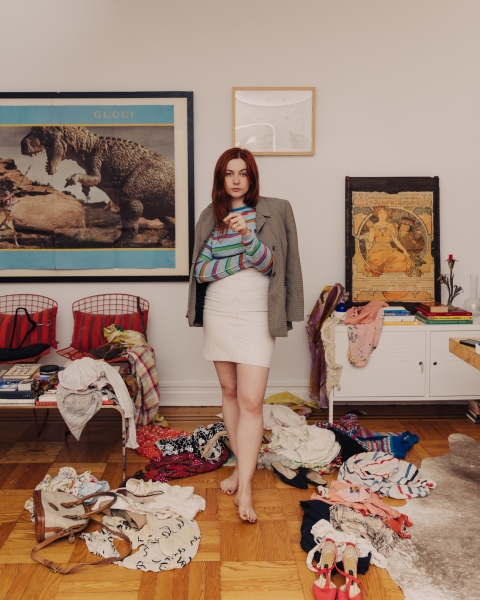It was a suburban Missouri dry cleaner that processed 125 items from my mother’s wardrobe after she died. Dresses were $5, but if you brought in a large amount, they’d do two for the price of one. And on Tuesdays pants were a dollar. With all the coupons added in, the bill was $375 cash. Aside from her books, which I couldn’t bear to sort through, her clothes told the story of her many lives: a dancer, a world traveler, a single mother, a college professor.
Being her only child, I inherited (or perhaps, assumed) all her belongings. Unlike me, who regularly purges or passes along clothes, my mother threw nothing away. So in March of 2018, eight months after she died, I flew home to St. Louis to sort through the 56 years of life she left behind.
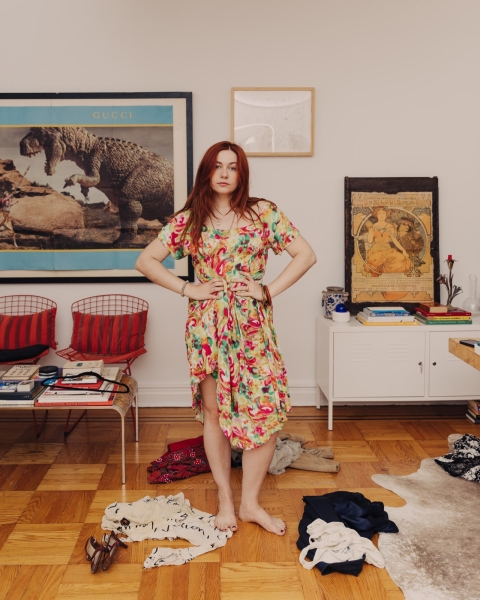
I was 23 and had just finished my first year working in magazines in New York. Between calls and after my New York colleagues signed off for the day, I sat in the basement of my grandmother’s ranch-style home, where my mother and I had lived for nearly a decade, opening bags, boxes, and drawers, trying to find meaning in things whose owner was gone.
My mother’s sartorial eras were well photographed. In the ’70s she changed from a Catholic-school uniform into leotards and eventually handsewn cancan costumes. At 16, she danced with Mikhail Baryshnikov when he performed with the Louisville Ballet. She spent her mid-to-late 20s in khaki shorts and linen button-downs, living in Southeast Asia for a Berkeley master’s program.
In Los Angeles, where I spent the first 12 years of my life, she wore Nanette Lapore from the thrift store, small heels that showed her dancers’ calves, shrunken cardigans, and leather bags. Her collection of little Betsey Johnson tops and mid-length skirts was unparalleled, and she was not afraid of patterns. As she grayed, her final era was that of a college professor: well-fitting denim, thrifted Ferragamo loafers from Out of the Closet in LA’s Atwater Village, a dark cornflower blue Coach bag, a white or light pastel button-down, and a blazer (preferably in wool because her circulation was bad).
During this time, my mother and I shared a large armoire and a hall linen closet; I remember the stacks of her jeans and button-ups in neat little piles behind the French doors. Her clothes were almost formulaic, and my memories of her pulling the top of each stack down are vibrant in my brain.
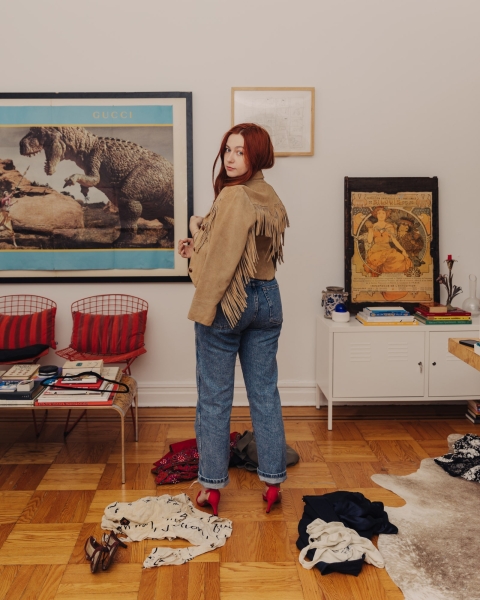
After we moved from Los Angeles to St. Louis to be closer to family, we continued the tradition of thrift shopping at a handful of Goodwills and Salvation Armys throughout the city. My prom dress, which she proudly found, cost $2.99. It was a black ’90s silhouette with a high neck and a long slit up the right leg from Saks. I nearly refused to try it on, but when I did it fit me like a glove. I felt a lot of pride wearing it, knowing that in a sea of mall-bought taffeta gowns, mine was one of a kind.
“Do you dry clean in bulk?” I remember calling to ask the dry cleaner up the road. “As long as you pay in cash, we don’t care how much you bring in,” the woman on the other end of the line told me. I’m sure they weren’t expecting more than a hundred pieces. “Gosh, did someone die?” the woman asked, carefully tallying up each piece. “Well, yes,” I replied. She eventually pulled out a calculator. The Archive of Suz, I call it, netted out about 200 pieces.

It really hadn’t been my intention to practically double my own closet by adding in my mother’s, but every bag or box unlocked new threads of memory that took me back to her. I tried on her wedding dress twice. I started to imagine what dive bar the Forever 21 set would end up in. And I gasped when a small collection of designer bags was uncovered. After a week or so of tireless sorting, I brought the mirror down from my childhood bedroom to see how things lived on my frame. Visitors would come sit on the floor with me—like my best friend and her six-month-old, who was just learning to roll around. He was born the day of her funeral—kismet.
As I was sorting, my unofficial godmother—a woman who happens to be an expert in both grief and organization—sent me rules that I still have printed out in a folder with my mother’s administrative death documents. “You will make mistakes—you will save too much, and you will throw things away that you regret.” Despite its gravity, this could never be a perfect practice.
When the boxes arrived from St. Louis to my apartment, I mixed those pieces with my own wardrobe. The clothing was a protective layer and a walking story all at once. In retrospect, while I certainly overdid it, her clothes felt so close to her, so I hoped making them my own would allow her to stay close to me. Unlike her art, which lines my walls, or her jewelry, which I bring out on special occasions, or even her ashes (which are tucked on my shelves between stacks of travel guides and a collection of vintage glass bottles), wearing her clothes meant she could step out into the world with me—the world of New York, which she never got to see me in.

I started to realize that her practice of uniform dressing has informed my own fashion philosophy. Everyone looks more put together in a blazer; you cannot own too many sweaters; a bias-cut floral dress will make you look like a woman; you don’t need to pay full price for good designer leather. (She paid $3 for her Gucci bag, which she likely found at an estate sale; the price is still written inside the purse in black Sharpie.)
The last time I saw my mother in a dress was at my college graduation. (I insisted she shave her legs; she was not thrilled.) It was the same one she wore to her father’s funeral: a black, floral, silk Anna Sui dress with a keyhole that she patched up with fabric to avoid cleavage. I tried to wear it to her memorial service the next year, her hand-stitched thread still visible, but it was too small for me. Instead, I wore a dress she had made from a pattern while she was in college. It was light cherry red with a spaghetti strap and a full circle skirt that showed off my waist and hips—a flattering silhouette that reminded her of her time as a dancer. The tightness in the rib cage felt corseted, but the dress was just expertly stitched like a second skin. It was powerful; I wore it again a year later on a second date.
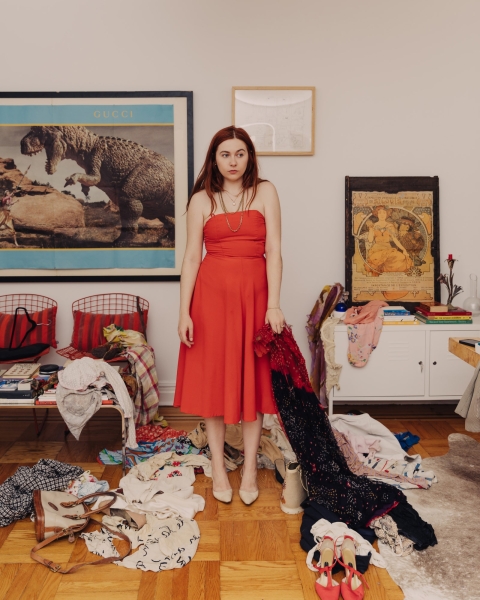
Her bras, all underwire, were Victoria’s Secret from the ‘90s—“workhorses,” she’d say, not like they make them now. They sit in my underwear drawer, unworn, taking up space—a physical manifestation of the grief.
Years later, I realize it was impossible for that process to have been clean. Perfection left the building the moment my mother died, but I’m not even sure it was there to begin with. She had taken her own life and had spent the prior six months as a person I didn’t recognize. This version of her, the one that was bipolar, was sparse during her time as my mother—at least to me—but according to her, it had reared its head throughout her lifetime. Motherhood, it seemed, gave her a sense of purpose, and whatever demons existed only reappeared when I moved to New York after college and her job as mother took a new form.
Unintentionally, I’ve turned my own wardrobe into a formula: the same stacks of jeans and blazers in every color routinely get pulled off a color-coded rack. We didn’t share clothes all that much when we were relatively the same size. She had no butt and larger breasts, and I was a suburban teenager who thought I had to be in head-to-toe Abercrombie to be socially relevant. But now I find every chance I can to step out in something of hers.
Recently, I opened a storage bin of her things when my friend and close collaborator Daniela Spector came over. We met because we are part of a club no one wants to be part of—women in their 20s and 30s who’ve lost their mothers, right at the cusp of womanhood. She was working on a project called Inheritance and asked if I’d wear my mother’s things for her photos. She, like me, has spent the time following her mother’s death documenting, discovering, carrying a pulse through the things and stories that remained. We played dress-up in my Brooklyn apartment, trying on and then piling up my mother’s archive—mostly thrifted, some handmade.
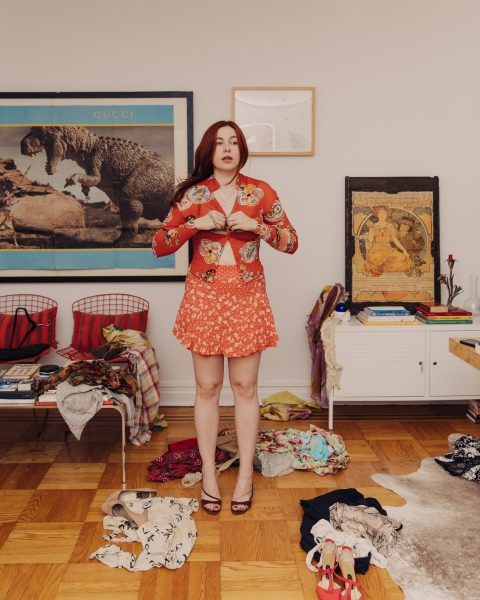
Since my mother’s death, I feel like it’s my duty to keep her possessions alive, if I couldn’t keep her alive. We still aren’t the same size, and that won’t change. (Some of her favorite pieces sit in my “when I really commit to Pilates” bin.) And I did save too much: 125 articles of clothing, in addition to my own growing wardrobe, was cumbersome. “You will make mistakes, this will not be perfect,” I chant to myself when I pass something of hers along—like a gorgeous French Connection dress I gave to my friend before her wedding, custom-tailored pants from Thailand to another, or a ’90s-era Alexander McQueen skirt I gifted my friend for her 30th birthday. People, even when gone, can show up in many ways. Now, my mother’s wardrobe covers the bodies of at least a dozen women in New York City, mine included. Her legacy looks a lot different than I guessed, but every time I reach for something of hers, there’s a new pulse—one that I thought I’d never hear again.

